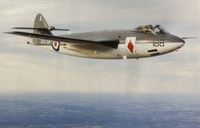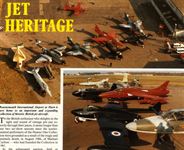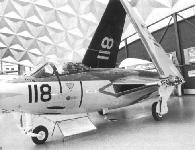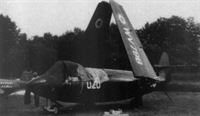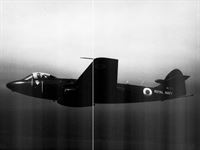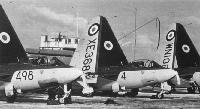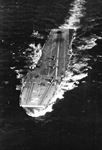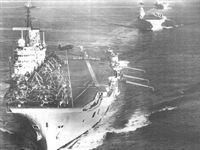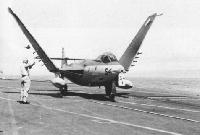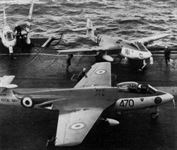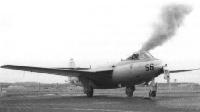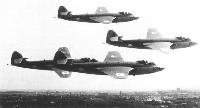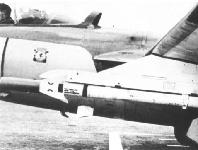
Описание
Страна : Великобритания
Год : 1947
Одноместный палубный истребитель и штурмовик
Hawker Sea Hawk
Прототипы самолета Sea Hawk - одного из наиболее эстетичных образцов творчества Сидни Кэмма - были построены в соответствии со спецификацией 7/46. Первый из трех опытных самолетов, обозначенный P.1040, поднялся в воздух 2 сентября 1947 года. После получения контракта компания построила 35 истребителей Sea Hawk F.Mk 1, затем производство и доработка полностью перешли к компании "Armstrong Whitworth". Еще 60 истребителей Sea Hawk F.Mk 1 и Sea Hawk F.Mk 2 были построены последней компанией, а затем был создан истребитель-бомбардировщик Sea Hawk FB.Mk 3, отличавшийся усиленным крылом. После выпуска 116 самолетов Sea Hawk FB.Mk 3 последовали 97 истребителей/штурмовиков Sea Hawk FGA.Mk 4. Все варианты, включая и последний самолет, были оснащены двигателем с двойным соплом Rolls-Royce Nene Mk 101 тягой 22,24 кН, позволявшим разместить топливо в хвостовой части фюзеляжа.
Установка на некоторые самолеты Sea Hawk FB.Mk 3 двигателя Nene Mk 103 привела к появлению модификации Sea Hawk FB.Mk 5. Кроме того, для британского флота были построены 86 самолетов FGA.Mk 6, также оснащенных двигателем Nene Mk 103, но в остальном идентичных модификации Mk 4. Sea Hawk эксплуатировался в ВМС до конца 1960 года, а 22 экспортных варианта Sea Hawk Mk 50 находились в Королевских ВМС Нидерландов до конца 1964 года. Другими основными экспортными вариантами были: Sea Hawk Mk 100 и всепогодный Sea Hawk Mk 101, заказанные морской авиацией Западной Германии. Они были аналогичны модели FGA.Mk 6, за исключением более высокого вертикального оперения. Кроме этого, на Mk 101 в обтекаемом контейнере под правым крылом была установлена поисковая РЛС Ekco Type 34. Самолеты действовали с береговых аэродромов, и только в середине 1960-х годов им на смену пришел Lockheed F-104G Starfighter.
Осенью 1959 года ВМС Индии - последний эксплуатант данной машины - заказали 24 самолета Sea Hawk FGA.Mk 6, часть из которых была заново построенными, а остальные являлись отремонтированными самолетами Mk 6 из состава авиации британского флота. Самолеты поступили в 300-ю эскадрилью, приписанную к авианосцу "Викрант", а позже к ним добавились еще 12 самолетов модификаций Sea Hawk FGA.Mk 4 и FGA.Mk 6, ранее принадлежавших морской авиации Великобритании, плюс 28 самолетов Hawk Mk 100 и Mk 101, переданных из Германии. Последние из всех этих машин в конце 1980-х годов были заменены на самолеты BAe Sea Harrier.
ТАКТИКО-ТЕХНИЧЕСКИЕ ХАРАКТЕРИСТИКИ
Hawker Sea Hawk FGA.Mk 6
Тип: одноместный палубный истребитель и штурмовик
Силовая установка: один ТРД Rolls-Royce Nene RN.4 Mk 103 тягой 24,02 кН
Летные характеристики: максимальная скорость на уровне моря 969 км/ч; начальная скороподъемность 1737 м/мин; набор высоты 13565 м - за 11 мин 50 с; практический потолок 13 565 м; боевой радиус без внешней подвески 370 км
Масса: пустого 4409 кг; максимальная взлетная 7348 кг
Размеры: размах крыла 11,89 м; длина 12,09 м; высота 2,64 м; площадь крыла 25,83 м!
Вооружение: четыре 20-мм пушки Hispano Mk 5 внизу носовой част фюзеляжа, плюс до 907 кг авиационных средств поражения на четырех подкрыльевых узлах подвески
- Описание
Фотографии
-
Air International 2008-02 / D.Hobbs - Hawker/Armstrong Whitworth Sea Hawk /Aircraft profile/
Регистрационный номер: WF186 Sea Hawk F.1 WF186/'BY-906', RNAS Brawdy Station Flight, circa 1957.
-
Air International 2008-02 / D.Hobbs - Hawker/Armstrong Whitworth Sea Hawk /Aircraft profile/
Регистрационный номер: WF259 Sea Hawk F.2 WF259/'124', 807 NAS, circa 1954.
-
Air International 2008-02 / D.Hobbs - Hawker/Armstrong Whitworth Sea Hawk /Aircraft profile/
Регистрационный номер: WM938 Sea Hawk FB.3 WM938/'131-Z', of 802 NAS, flying from HMS Albion.
-
Мировая Авиация 153
Регистрационный номер: WM995 Во время Суэцкого кризиса 1956 года самолеты получили специальные опознавательные полосы - как этот Sea Hawk FB.Mk 3, воевавший в небе Египта в составе 802-й эскадрильи, приписанной изначально к авианосцу "Арк Ройял", но на время кризиса переданной "Альбиону".
-
Air International 2008-02 / D.Hobbs - Hawker/Armstrong Whitworth Sea Hawk /Aircraft profile/
Регистрационный номер: WV870 Sea Hawk FGA.4 WV870/'LM-649' of 738 NAS, based at RNAS Lossiemouth
-
Air International 2008-02 / D.Hobbs - Hawker/Armstrong Whitworth Sea Hawk /Aircraft profile/
Регистрационный номер: XE489 Sea Hawk FGA.6 XE489/'026', Fleet Requirements Unit, Hurn, operated by Airwork Services Ltd.
-
Мировая Авиация 11
Регистрационный номер: XE409 [2] Sea Hawk FGA.Mk 6. Этот Sea Hawk FGA. Mk 6 с черными и желтыми полосами, нанесенными специально перед суэцкой операцией в ноябре 1956 года, из 804-й эскадрильи (FAA) действовал с авианосца "Bulwark" и совершал налеты на египетские аэродромы, а также участвовал в поддержке наземных операций. В начале 1957 года, после возвращения из Суэца, эскадрилья дислоцировалась на авианосце " Ark Royal".
-
Air International 2008-02 / D.Hobbs - Hawker/Armstrong Whitworth Sea Hawk /Aircraft profile/
Регистрационный номер: XE335 [2] Sea Hawk FGA.6 XE335/234-ZB, 810 NAS, HMS Albion.
-
Air International 2008-02 / D.Hobbs - Hawker/Armstrong Whitworth Sea Hawk /Aircraft profile/
Sea Hawk FGA.50 118 of 860 Squadron, Royal Netherlands Naval Air Service, early 1960s.
-
Мировая Авиация 110
Регистрационный номер: WV908 [13] Sea Hawk FGA.Mk 6 блистает символикой 806-й эскадрильи авиации британских ВМС. В состав исторического звена Королевского флота истребитель был включен в сентябре 1982 года. Сейчас это единственный в мире пригодный к полетам Sea Hawk.
-
Aeroplane Monthly 1997-02 / Hawker Sea Hawk FGA.6 WV908 /Preservation Profile/
Регистрационный номер: WV908 [13] -
Aviation Historian 33 / M.Willis - From reject to rocketship
Регистрационный номер: VP401 [24] A characteristically splendid photograph by Charles E. Brown of P.1040 VP401 in its silver finish leaving a fuel vapour trail above the clouds in the late summer of 1947. Compared to its propeller-driven predecessors, the P.1040 was the epitome of the modern fighter
-
Air International 2008-02 / D.Hobbs - Hawker/Armstrong Whitworth Sea Hawk /Aircraft profile/
Регистрационный номер: WV908 [13] FGA.6 WV908 is the only Sea Hawk still flying. It is operated, appropriately, in the markings of 806 NAS by the Royal Navy Historic Flight at RNAS Yeovilton. Originally delivered in 1955, it was restored to flying condition by RNAS Cold rose in 1977 and has formed part of the RNHF since 1982.
-
Мировая Авиация 136
Регистрационный номер: WV908 [13] Этот Sea Hawk FGA.Mk 6(№ WV908), снятый с вооружения в 1960 году, восстановили до летного состояния в середине 1970-х годов. Вновь самолет поднялся в воздух в 1978 году в окраске 806-й эскадрильи британских ВМС. Истребитель включили в состав Исторического звена британских ВМС. В 1990-е годы WV908 прошел ремонт на "British Aerospace", но в июле 1997 года из-за повреждения двигателя его полеты были прекращены. Изначально восстановление аппарата до летного состояния не планировалось, но в 1998 году было объявлено о ремонте. Самолет выполнил очередной свой первый полет в 2004 году и ныне является единственным летающим Sea Hawk.
-
Jane's All the World Aircraft 1980 / Encyclopedia of Aviation - Aircraft A-Z - v3
Регистрационный номер: WV908 [13] Hawker Sea Hawk FGA.4.
-
Aeroplane Monthly 1997-02 / Hawker Sea Hawk FGA.6 WV908 /Preservation Profile/
Регистрационный номер: WV908 [13] The colour picture was taken during WV908’s first post-restoration flight from Dunsfold on October 23, 1996, with Lt-Cdr Dave Baddams at the controls. It wears the markings of 806 Naval Air Squadron.
-
Aeroplane Monthly 1976-05 / R.Williams - Hawker Sea Hawk
Sea Hawks of 801 Squadron, aboard HMS Bulwark in the Caribbean, 1958, fire their cartridge starters.
-
Air Enthusiast 1972-12 / P.Chopra - Indian ocean air power
Although the Sea Hawk equips only one squadron - INAS 300 - a total of 74 of these Hawker-designed, Armstrong-Whitworth-built fighters has been acquired by India over the years, including 28 from the German Navy.
-
Мировая Авиация 136
Sea Hawk FGA.Mk 6 с подвешенными ракетами из 300-й эскадрильи "White Tiger" ВМС Индии на авианосце "Викрант". Также в кадр попали вертолет Alouette III и несколько противолодочных самолетов Alize. Mk 6 с авианосца "Викрант" принимали участие в индо-пакистанской войне 1971 года.
Другие самолёты на фотографии: Breguet Br.1050 Alize - Франция - 1956Sud-Aviation Alouette III / SA.316 / SA.319 - Франция - 1959
-
Air Enthusiast 1972-12 / P.Chopra - Indian ocean air power
Scene aboard the INS Vikrant, showing an Alize on the between-decks lift and Sea Hawks on the flight deck.
Другие самолёты на фотографии: Breguet Br.1050 Alize - Франция - 1956
-
Мировая Авиация 105
Регистрационный номер: IN153 Эскадрильи № 300 "White Tigers" на Sea Hawk и № 310 "Cobras" на Alize, действовавшие с авианосца "Викрант", решали широкий круг задач, включая патрулирование, противолодочные операции, постановку мин и штурмовые удары.
Другие самолёты на фотографии: Breguet Br.1050 Alize - Франция - 1956
-
Air International 2008-02 / D.Hobbs - Hawker/Armstrong Whitworth Sea Hawk /Aircraft profile/
India was the last country to buy Sea Hawks and the Indian Navy operated them for by far the longest period. No 300 Indian Naval Air Squadron flew the type from 1960 until they were replaced by Sea Harriers in 1984.
-
Air Enthusiast 1972-12 / P.Chopra - Indian ocean air power
Close-up of the White Tiger emblem of INAS 300, the Sea Hawk-equipped fighter squadron.
-
Air Enthusiast 2003-11 / A.Thomas - Fighter finale
No.120 of 860 Squadron spreads its wings for another sortie at Valkenburg during the early 1960s.
-
Air Enthusiast 2003-11 / A.Thomas - Fighter finale
Final Dutch Sea Hawk was F-71, at Bitteswell before delivery on January 28, 1951.
-
Мировая Авиация 136
Регистрационный номер: VA+229 [4] Самолету Sea Hawk сопутствовал ограниченный экспортный успех. С 1958 года ФРГ получила 68 Mk 100 и Mk 101, оснащенных РЛС. VA-229 - противокорабельный Mk 100.
-
Air International 2008-02 / D.Hobbs - Hawker/Armstrong Whitworth Sea Hawk /Aircraft profile/
Регистрационный номер: VA+229 [4], VA+230 [3], VA+231 [3] Marineflieger Geschwader 1 Sea Hawks (seen here) had full carrier operating capability for potential use from NATO aircraft carriers and they proved effective in service until replaced by Lockheed F-104 Starfighters from 1965. The black fairing on the upper rear fuselage contains a directional antenna and was a distinctive feature of all Marineflieger Sea Hawks.
-
Air International 1989-05 / ??? - Jet Heritage /Veteran & Vintage/
Регистрационный номер: G-SEAH, WM994 The Hawker Sea Hawk FB Mk 5 G-SEAH (ex WM994), under restoration to flying condition.
-
Air International 1989-05 / ??? - Jet Heritage /Veteran & Vintage/
Two views of the Jet Heritage collection present at Hurn in February 1989.
Другие самолёты на фотографии: De Havilland Venom / D.H.112 - Великобритания - 1949Gloster, Armstrong Whitworth Meteor NF.11 - Великобритания - 1950Hawker Hunter T - Великобритания - 1955Hunting Percival Jet Provost / P.84 - Великобритания - 1954Supermarine Swift - Великобритания - 1948
-
Aeroplane Monthly 1976-05 / R.Williams - Hawker Sea Hawk
Регистрационный номер: VP401 [24] The unpainted VP401 immediately after roll out at Langley in 1947.
-
Air Enthusiast 2003-07 / T.Buttler - UK jet pioneers (2)
Регистрационный номер: VP401 [24] Nose view of the Hawker P.1040 prototype VP401, September 1947.
-
Aviation Historian 33 / M.Willis - From reject to rocketship
Регистрационный номер: VP401 [24] A rear view of VP401 at Boscombe Down in September 1947. The first prototype was originally fitted with a Rolls-Royce Nene I centrifugal-flow turbojet engine of 4,500lb-thrust, later replaced by a more powerful Nene II of 5,000lb-thrust. The mainwheels, attached to the centre-section stub wings, retracted neatly into the fuselage.
-
Aviation Historian 33 / M.Willis - From reject to rocketship
Регистрационный номер: VP401 [24] The shape of things to come - VP401 as first flown in September 1947 at Boscombe Down, with the original rectangular exhaust fairings and a nose-attitude reference mast ahead of the cockpit. Interestingly, in its issue of September 5, 1947, British weekly aviation magazine The Aeroplane referred to the P.1040 as the "Zephyr”, although it offered a correction the following week stating that it was in fact not so named.
-
Aeroplane Monthly 1979-06 / B.Gunston - Hawker Hunter, part 1 /Fighters of the fifties/ (23)
Регистрационный номер: VP401 [24] Progenitor of the line which culminated in the Hunter was the P.1040
-
Мировая Авиация 136
Регистрационный номер: VP401 [24] Самолет с бортовым номером VP401 - прототип P.1040, разработанный в последние военные месяцы. Первый полет машина выполнила 2 сентября 1947 года. Самолет стал основой для создания двух прототипов по спецификации N.7/46 Королевского ВМФ.
-
Aviation Historian 33 / M.Willis - From reject to rocketship
Регистрационный номер: VP401 [24] Another of Cyril Peckham’s air-to-air portraits, showing the distinctive modified “pen-nib” exhaust fairings aft of the wing’s trailing edge. The original highly curved canopy, however, which Wade complained had a tendency to distort the pilot’s view forward, is still fitted.
-
Aeroplane Monthly 1976-05 / R.Williams - Hawker Sea Hawk
Регистрационный номер: VP401 [24] A view of the first P.1040, VP401, which displays the "pen nib” jet efflux fairings.
-
Aeroplane Monthly 1986-09 / ??? - At last! the 1948 show
Регистрационный номер: VP401 [24] “Wimpey" Wade displaying the Hawker P.1040
-
Aviation Historian 33 / M.Willis - From reject to rocketship
Регистрационный номер: VP401 [24] Showing off its extremely clean lines, VP401 was captured in this magnificent air-to-air study by Hawker’s regular photographer Cyril Peckham in 1948 or 1949, with Wade at the controls. Shown to good effect in this head-on view are the type’s air intakes and relatively thin outer wing sections, with a thickness-to-chord ratio of 0.095:1.
-
Air Enthusiast 2003-07 / T.Buttler - UK jet pioneers (2)
Регистрационный номер: VP401 [24] One of the most aesthetically pleasing jets ever, the Hawker P.1040 prototype VP401.
-
Aviation Historian 33 / M.Willis - From reject to rocketship
Регистрационный номер: VP401 [24] Sporting the revised canopy, with a flat windscreen on the forward section, VP401 is seen here at Langley for its first public display on August 24, 1948. During it, according to The Aeroplane, Trevor Wade ‘‘did full justice to the occasion and showed the paces of his mount in one of the ablest displays we have seen for some time”.
-
Aviation Historian 33 / M.Willis - From reject to rocketship
Регистрационный номер: VP401 [24] Hawker test pilot Trevor "Wimpy” Wade in the cockpit of VP401 at the Hawker factory at Langley. For its first flight on September 2, 1947, VP401 was sent to Boscombe Down, which had a more suitable runway than Langley’s grass. Three days after its maiden flight the aircraft went to Farnborough, for the continuation of trials.
-
Aviation Historian 33 / M.Willis - From reject to rocketship
Регистрационный номер: VP401 [24] Sporting red/orange bands around the rear fuselage and racing number “87", VP401 awaits its next race at Elmdon in July-August 1949. To the left is Blackburn Firebrand EK621, which raced against VP401 for the Kemsley Challenge Trophy, and to the right, D.H.108 VW120, which lost out to VP401 in the SBAC Challenge Cup.
Другие самолёты на фотографии: Blackburn Firebrand / B-37 - Великобритания - 1942De Havilland Swallow / D.H.108 - Великобритания - 1946
-
Aviation Historian 33 / M.Willis - From reject to rocketship
Регистрационный номер: VP401 [24] Another photograph of VP401 at Elmdon, this time refuelling in front of D.H.103 Hornet PX386, which was to compete against VP401 in the Kemsley Challenge Trophy race - which the N.7/46 won, piloted by Neville Duke. With the introduction of jets, the UK’s National Air Races truly represented the ‘‘fastest racetrack in the world”.
Другие самолёты на фотографии: De Havilland Hornet / Sea Hornet / D.H.103 - Великобритания - 1944
-
Aviation Historian 33 / M.Willis - From reject to rocketship
Регистрационный номер: VP401 [24] With the fitting of an Armstrong Siddeley Snarler rocket motor in its extreme tail in the early summer of 1950, VP401 became the P.1072 experimental research aircraft. The Nene engine remained largely unaffected, but the entire fuel system was revised, with the aircraft’s original 395gal turbojet fuel load reduced to 175gal.
-
Aviation Historian 33 / M.Willis - From reject to rocketship
Регистрационный номер: VP401 [24] VP401 has its Snarler motor refuelled, the liquid oxygen vapourising on contact with the air. The Snarler’s inspection panels have been removed, as has the fairing over the external pipework channelling fuel and propellant from the tanks located forward of the jet engine along the underside of the fuselage.
-
Aviation Historian 33 / M.Willis - From reject to rocketship
Регистрационный номер: VP401 [24] The business end of the P.1072 - VP401 following modification to P.1072 specification, showing the combustion chamber of the Snarler. Owing to modifications to the tail to accommodate the rocket motor, the rudder lost some area at the bottom.
-
Aeroplane Monthly 1999-10 / B.Jones - Perfecting the power /Airborne engine testbeds/
Регистрационный номер: VP401 [24] The Armstrong Siddeley Snarler rocket motor was installed in the rear fuselage of the prototype Hawker P.1040, redesignated P.1072. Liquid oxygen was fed from a forward fuselage tank through a ventral pipe, seen uncovered beneath the fuselage.
-
Aeroplane Monthly 1983-12 / D.Middleton - Neville Duke /Test Pilot Profile/ (8)
Регистрационный номер: VP401 [24] The first Hawker P.1040, VP401, was later fitted with a Snarler rocket and became the P.1072.
-
Air Enthusiast 2003-07 / T.Buttler - UK jet pioneers (2)
Регистрационный номер: VP401 [24] P.1040 VP401 was converted to mixed powerplant format with an Armstrong Siddeley Snarler rocket as well as the Nene, as the P.1072. It is illustrated at Bitteswell under flight test in mid-1951.
-
Aviation Historian 33 / M.Willis - From reject to rocketship
Регистрационный номер: VP401 [24] The first take-off of the P.1072 under rocket power, from Armstrong Siddeley’s airfield at Bitteswell on November 20, 1950, with Wade at the controls. The forward fuselage housed 75gal of liquid oxygen in a spherical tank, while aft of the rear paraffin tank was another tank carrying 120gal of water-methanol for the rocket motor.
-
Aviation Historian 33 / M.Willis - From reject to rocketship
Регистрационный номер: VP401 [24] The final curtain - VP401’s last major role was as part of the static display at the SBAC Show at Farnborough in September 1951. The P.1072 was presented by Armstrong Siddeley Motors rather than Hawker, although the relationship between the two manufacturers was displayed on the aircraft in the form of a Hawker Siddeley Group emblem on the nose.
-
Aviation Historian 20 / M.Willis - How to build a Sea Hawk
Регистрационный номер: VP413 [3] The second Hawker N.7/46 prototype, VP413, photographed by Cyril Peckham after its completion. The type marked a radical change of direction for Hawker, but ultimately proved to be an excellent example of ingenious engineering solutions, remaining in service with the Royal Navy for more than 15 years.
-
Aeroplane Monthly 1976-05 / R.Williams - Hawker Sea Hawk
Регистрационный номер: VP422 [3] The second N.7/46, VP422, which was used for preliminary service evaluation in 1950.
-
Aviation Historian 20 / M.Willis - How to build a Sea Hawk
Регистрационный номер: WF144 [2] The finished article - a fine Cyril Peckham study of WF144, the second production example of the Sea Hawk F Mk 1. Only 35 Sea Hawks were produced by Hawker (apart from the prototypes) before production moved to Armstrong-Whitworth at Baginton. This aircraft differed from the prototypes by having square-ended elevators, a redesigned cockpit canopy and a longer arrester hook; otherwise it was very similar, lacking features of later production aircraft such as the “acorn” fairing at the intersection of the fin and tailplane and underwing weapon hardpoints.
-
Aeroplane Monthly 1976-05 / R.Williams - Hawker Sea Hawk
Регистрационный номер: WF145 [2] The second production aircraft made carrier trials on HMS Eagle with WF145.
-
Aeroplane Monthly 1976-05 / R.Williams - Hawker Sea Hawk
Регистрационный номер: VP422 [3] The second navalised prototype N.7/46, VP422, made its maiden flight in October 1949. It had a lengthened arrester hook, drop-tank pick-up points and provision for RATOG. Note the gun ports in the nose.
-
Aeroplane Monthly 1976-05 / R.Williams - Hawker Sea Hawk
Регистрационный номер: WF143, WF144 [2], WF145 [2] The first three production Sea Hawk F 1s WF144, WF143 and WF145.
-
Авиация и Космонавтика 2001-07 / М.Никольский - Развитие авиации корабельного базирования после Второй мировой войны
Регистрационный номер: VP413 [3] "Си Хоук"
-
Aviation Historian 20 / M.Willis - How to build a Sea Hawk
Регистрационный номер: VP413 [3] Although it is not specified in the material, it is likely that the aircraft seen being constructed in the preceding photographs was the second N.7/46 prototype, VP413 - which, unlike the first, included folding wings, catapult spools and full gun armament. The aircraft made its maiden flight on September 3, 1948, after which it went to Boscombe Down for dummy deck assessment trials. It was then flown on to HMS Illustrious, aboard which it is seen here, for take-off, landing and general handling trials.
-
Aeroplane Monthly 1990-02 / G.Webb - FAA portfolio
Регистрационный номер: WM961 Hawker Sea Hawk WM961 of 802 Sqn, probably landing on HMS Eagle, in 1956.
-
Aeroplane Monthly 1976-05 / R.Williams - Hawker Sea Hawk
Регистрационный номер: WM916 Sea Hawk FB 3 WM916 of 806 Squadron catches one of HMS Centaur’s arrester wires.
-
Aeroplane Monthly 1980-01 / R.Wilson, R.Winslade - Naval Nostagia
Регистрационный номер: WV908 [13] Hawker Sea Hawk WV908, photographed by Richard Wilson, was restored at RNAS Culdrose
-
Aeroplane Monthly 1989-12 / M.Oakey - Grapevine
Регистрационный номер: WV908 [13] Hawker Sea Hawk FGA.6 WV908 of the Royal Navy Historic Flight made a 1hr test flight from Yeovilton on September 20, 1989 following a 3yr overhaul. Sadly, says the Navy, funding will not be available for the aircraft to appear on the display circuit next year.
-
Авиация и Космонавтика 2001-07 / М.Никольский - Развитие авиации корабельного базирования после Второй мировой войны
Регистрационный номер: WV908 [13] "Си Хоук" FGA.4 из 806-й эскадрильи
-
Air International 1986-07 / ??? - Under Two Hats /Veteran & Vintage/
Регистрационный номер: WV908 [13] The only jet type in the Historic Flight at present is the Hawker Sea Hawk WV908, which flies in the markings of 806 NAS, the well-known Ace of Diamonds squadron. Of other jet types that served with the Royal Navy, examples of only the Phantom FG Mk I now remain airworthy.
-
Aeroplane Monthly 1978-08 / News Spotlight
Регистрационный номер: WV908 [13] Hawker Sea Hawk WV908 flew for the first time after restoration at Culdrose on May 23, 1978. Its original maiden flight was on December 31, 1954, and it served as an FGA.4 with 807 and 898 FAA Squadrons and as an FGA.6 with 806 and 738 Squadrons before retirement on June 29, 1962. It now wears 806 Squadron markings.
-
Aeroplane Monthly 1976-05 / R.Williams - Hawker Sea Hawk
Регистрационный номер: WV799 A fine shot of FGA 4 WV799 of 804 Squadron touching down on HMS Eagle in May 1955.
-
Aeroplane Monthly 1997-02 / Hawker Sea Hawk FGA.6 WV908 /Preservation Profile/
Регистрационный номер: WV908 [13] WV908 with 738 Sqn, FAA, at Lossiemouth, where it was used for operational flying training in the early 1960s.
-
Aeroplane Monthly 1976-05 / R.Williams - Hawker Sea Hawk
Регистрационный номер: WV840 Sea Hawk FGA 4 WV840 is seen with a pair of underwing drop tanks fitted with refuelling probes. The flight refuelling trials, made in 1957, proved unsuccessful.
-
Air Enthusiast 2003-11 / A.Thomas - Fighter finale
Регистрационный номер: WV828 Former Royal Navy FGA.6 WV828 painted as '118' on show at the Aviodome. It is now at De Kooy.
-
Aeroplane Monthly 1982-01 / Grapevine
Регистрационный номер: WV798 Leisure Sport’s Sea Hawk WV798 has been purchased by Bob Coles and is currently on loan to the Second World War Aircraft Preservation Society at Lasham.
-
Air Pictorial 1958-08 / Photo Review
Регистрационный номер: WM920 At R.N.A.S. Ford, 21st June, an Armstrong Whitworth-built Hawker Sea Hawk FGA. Mk. 6 (WM920) sporting a new F.A.A. grey and white decor.
-
Air Pictorial 1957-02 / Air Pictorial's photo-review
Регистрационный номер: XE335 [2] INVASION MARKINGS for Suez operations are visible on this Armstrong Whitworth Sea Hawk F(GA). Mk. 6 (XE335). Fin letter "z" indicates "234" is from H.M.S. Albion. The underwing tanks are larger than normal 45-gall. (unfinned) drop tanks.
-
Aeroplane Monthly 1983-03 / P.Jarrett - Grapevine
Some of Southend's Historic Aircraft Museum residents in happier days - Sea Hawk, J-29, Avro XIX, Beverley and Harvard.
Другие самолёты на фотографии: Avro Anson X - Великобритания - 1943Blackburn Beverley / B-101 - Великобритания - 1950North American T-6 Texan / AT-6 Harvard - США - 1935SAAB Tunnan / J-29 - Швеция - 1948
-
Aeroplane Monthly 1983-07 / P.Jarrett - Grapevine
The Sea Hawk, J-29, Drover, Beverley and Vampire await their lot.
Другие самолёты на фотографии: Blackburn Beverley / B-101 - Великобритания - 1950De Havilland Vampire T / Vampire NF / D.H.113 / D.H.115 - Великобритания - 1950De Havilland Australia DHA-3 Drover - Австралия - 1948SAAB Tunnan / J-29 - Швеция - 1948
-
Aeroplane Monthly 1976-05 / R.Williams - Hawker Sea Hawk
Регистрационный номер: XE339 [2] All-black FGA 6 XE339 of the Fleet Requirements Unit at Hum. These aircraft were operated by Airwork Ltd on behalf of the RN.
-
Aeroplane Monthly 1985-05
Регистрационный номер: XE339 [2] ADRIAN M. BALCH'S photograph of FRU Hawker Sea Hawk FGA.6 XE339 near Hurn, Bournemouth, on June 5, 1968.
-
Aeroplane Monthly 1976-05 / R.Williams - Hawker Sea Hawk
P. M. R. Walton of Armstrong Whitworth poses his FGA 6, fitted with an assortment of stores, during the 1956 SBAC display.
-
Aeroplane Monthly 1976-05 / R.Williams - Hawker Sea Hawk
Регистрационный номер: WV854 FGA 6 WV854 of 803 Squadron, above, fires off its rocket projectiles, having already released two 500lb bombs.
-
Air Pictorial 1957-10 / J.Stevens - S.B.A.C. 1957
"The Red Devils", comprising five Sea Hawks of No. 738 F.A.A. Squadron executing the spectacular smoke-trailing "up, down and over".
-
Jane's All the World Aircraft 1980 / Encyclopedia of Aviation - Aircraft A-Z - v3
Hawker Sea Hawk F.1 on board HMS Eagle.
-
Aeroplane Monthly 1986-01 / 1986 UK Aircraft Collections and Museums Guide
Регистрационный номер: WN108, XE368 Hawker Sea Hawk XE368 and others.
-
Aeroplane Monthly 1979-03 / J.Corlett - One good turn
Регистрационный номер: WF159, WF289, WM908, WM918 The Hawker Sea Hawks of the School of Aircraft Handling, RNAS Culdrose (HMS Seahawk), fire their cartridges in unison during the “At Home” day in July 1960.
-
Мировая Авиация 136
Регистрационный номер: WV919, XE399 Количество Sea Hawk в авиации британского флота достигло своего пика к моменту Суэцкого кризиса 1956 году. Снимок палубы авианосца "Арк Ройал" сделан в 1957 или 1958 году. На переднем плане - FGA.Mk 6 из 804-й эскадрильи, дальше стоят FB.Mk 5 из 802-й эскадрильи. Справа - de Havilland Sea Venom FAW.Mk 21 из 893-й эскадрильи.
Другие самолёты на фотографии: De Havilland Venom / D.H.112 - Великобритания - 1949
-
Aeroplane Monthly 1990-02 / G.Webb - FAA portfolio
Регистрационный номер: WV852, WV856, WV902, WV912, XE396, XE409 [2] Hawker Sea Hawks of Nos 898 and 804 Sqn aboard HMS Ark Royal in February 1957. Some 893 Sqn Sea Venoms are just visible at left.
Другие самолёты на фотографии: De Havilland Venom / D.H.112 - Великобритания - 1949
-
Мировая Авиация 197
Самолеты Skyraider AEW.Mk 1, Gannet и Sea Hawk на палубе британского авианосца "Арк Ройял". Самолеты ДРЛО Gannet AEW.Mk 3 заменили в этой роли Skyraider.
Другие самолёты на фотографии: Douglas AD-3W - США - 1949Fairey Gannet - Великобритания - 1949
-
Aeroplane Monthly 1988-03 / Personal album. Military
An 813 Sqn Westland Wyvern lands on HMS Eagle in June 1955, Sea Hawks can be seen parked forward of the carrier's island. No 813 Sqn operated Wyvern S.4s from May 1953 until November 1955 and again from November 1956 to April 1958.
Другие самолёты на фотографии: Westland Wyvern - Великобритания - 1946
-
Мировая Авиация 40
Регистрационный номер: XE392 Октябрь 1957г.: в учении "Pipe Down" принял участие авианосец "Арк Ройал", на котором базировались 41-я истребительная эскадрилья "Jolly Rogers" (VF-41, самолеты F3H-2M) и 804-я эскадрилья (Seahawk FGA.Mk 6).
Другие самолёты на фотографии: McDonnell F3H Demon - США - 1951
-
Air-Britain Aeromilitaria 1983-03
A view of HMS Albion. Having a resident photogarphic section and a variety of aircraft to take snapshots from is very convenient. On the deck are three Sea Hawks and a Skyraider AEW.1. 'Albion' having the initial 'A', it follows that the letter 'Z' was allotted as an ident letter for the bows. Note the first Sea Hawk ready for catapulting from the port catapult.
Другие самолёты на фотографии: Douglas AD-3W - США - 1949
-
Air Enthusiast 1998-03 / J.Smith - Wrath of a Mystical Monster
HMS ‘Eagle’ with ‘Bulwark’ and ‘Albion’ behind. On the deck, bow to stern, are Sea Venoms, Sea Hawks, Wyverns, a Dragonfly helicopter and an Avenger
Другие самолёты на фотографии: De Havilland Venom / D.H.112 - Великобритания - 1949Grumman TBF/TBM Avenger - США - 1941Westland Dragonfly / Widgeon - Великобритания - 1948Westland Wyvern - Великобритания - 1946
-
Air Pictorial 1955-04
Hawker Sea Hawks of the Fleet Air Arm ranged in the forward safety area on the flight deck of H.M.S. Centaur, off the coast of Malta. This photograph was taken by Gloster Aircraft's chief photographer Russell Adams from a Sikorski S.51 helicopter.
-
Авиация и Время 2004-06 / А.Котлобовский, М.Жирохов - Пылающий Индостан (10)
Индийский авианосец "Викрант" выходит в море
Другие самолёты на фотографии: Breguet Br.1050 Alize - Франция - 1956
-
Air Enthusiast 1972-12 / P.Chopra - Indian ocean air power
INS Vikrant, the Indian Navy's sole aircraft carrier, was laid down during World War II as the light fleet carrier HMS Hercules and was completed, with angled deck, in 1961. Her normal complement of aircraft comprises one squadron of Sea Hawk fighters and flight of anti-submarine Alizes and Sea Kings.
Другие самолёты на фотографии: Breguet Br.1050 Alize - Франция - 1956
-
Авиация и Время 2004-06 / А.Котлобовский, М.Жирохов - Пылающий Индостан (10)
Регистрационный номер: IN164, IN167 "Си Хоки" отправляются на очередное задание
Deck scene aboard the Vikrant as Sea Hawks of INAS 300, the White Tigers, are launched for a training exercise. Replacement of the Sea Hawks is now a matter of high priority, with the Harrier currently considered to be the most likely choice if the problem of financing can be resolved. -
Aeroplane Monthly 1976-05 / R.Williams - Hawker Sea Hawk
Регистрационный номер: IN157 One of the Indian Navy FGA 6s, IN157 of INAS 300, aboard INS Vikrant.
-
Air Enthusiast 2003-11 / A.Thomas - Fighter finale
F-54 of 860 Squadron is marshalled onto catapult for a launch during carrier operations in the late 1950s.
-
Air Enthusiast 2003-11 / A.Thomas - Fighter finale
Steam streams from the catapult as 860's F-68 begins its take-off run from 'Karel Doorman's' deck.
-
Aeroplane Monthly 1997-02 / Hawker Sea Hawk FGA.6 WV908 /Preservation Profile/
Регистрационный номер: WV908 [13] A post-Suez study of WV908 in Ark Royal in 1957 as “470” of 898 Sqn, FAA.
-
Air Enthusiast 1998-03 / J.Smith - Wrath of a Mystical Monster
A Sea Hawk from 899 Squadron takes-off from ‘Eagle’ - note the air-to-ground rocket armament and the ‘Suez stripes’. Faster than the Wyvern, the Hawk could carry nearly the same ordnance load.
-
Air Enthusiast 2003-11 / A.Thomas - Fighter finale
Smoke pours from the port side vent as the Nene engine's cartridge starter is fired before F-56 of 3 Squadron departs on another sortie. The squadron's white nose flash in shown.
-
Air Pictorial 1957-09
The first Dutch Armstrong Whitworth Sea Hawk in Royal Netherlands Navy insignia was F-50, which is seen during a check flight from Bitteswell prior to delivery on July 19, 1957.
-
Air Enthusiast 2003-11 / A.Thomas - Fighter finale
During the later 1950s 3 Squadron, the test and training unit, conducted trials to introduce the Philco-built AIM-9 Sidewinder 1A infra-red heat-seeking missiles onto the Sea Hawk.
-
Air Enthusiast 2003-11 / A.Thomas - Fighter finale
During its final year, 860 Squadron formed the 'Sea Lords' aerobatic team with four Sea Hawks. Nos.119, 120, 129 and 131 here performing over Scheveningen in July 1964.
-
Aeroplane Monthly 1976-05 / R.Williams - Hawker Sea Hawk
Регистрационный номер: VA+229 [4], VA+230 [3], VA+231 [3] A trio of high-finned Sea Hawk Mk 100s from the first batch for the West German Navy.
-
Jane's All the World Aircraft 1980 / Encyclopedia of Aviation - Aircraft A-Z - v3
Регистрационный номер: VA+229 [4], VA+230 [3], VA+231 [3] Hawker Sea Hawk Mk 100s in German Marineflieger markings.
-
Air Enthusiast 2003-11 / A.Thomas - Fighter finale
Close-up of the Sidewinder installation.
-
Air Pictorial 1957-01
A recently developed (by No . 802 Squadron, R.N.A.S., Lossiemouth, Scotland) target banner streaming device called "Excelsior" is revealed in these three photographs.
-
Aeroplane Monthly 1983-08 / P.Jarrett - Grapevine
Регистрационный номер: WN994 In the Fabricair hangar at Southend Airport, Essex, Hawker Sea Hawk WN994, is being prepared to fly again.
-
Air Pictorial 1957-01
Регистрационный номер: WV909 The close-up shows the banner 'chute and the inboard ("fluid flywheel") towing cable drum. The device is now cleared for use on all Fleet Air Arm Hawker (Armstrong-Whitworth-built) F(GA) Mk. 4 Sea Hawks (WV909 illustrated).
-
Aviation Historian 20 / M.Willis - How to build a Sea Hawk
LEFT The first image from the Hawker material shows a pressed light-alloy fuselage frame from the area of the wing-root intakes, illustrating the recesses where ducting will guide air to the Rolls-Royce Nene engine. The frame has been photographed upside-down; when installed in the airframe, the flat inside edge should be at the base. Notches in the outer edges of the frame are to accommodate the fuselage’s longerons and stringers.
RIGHT In terms of construction this light-alloy fuselage frame is conventional, although its shape is unusual. The “V” shape in the lower part of the frame was adopted to create space within the fuselage for the main undercarriage bay. The N.7/46’s thin wing left less space for the undercarriage than in previous piston-engined designs, while the large-diameter engine and the thicker wing roots required for the intakes left space free just aft of the engine, which Hawker used to house the mainwheels when retracted. The space in the upper half was for a saddle-type fuel tank sitting over the aft end of the engine. The wings were too thin to incorporate fuel tanks. -
Aviation Historian 20 / M.Willis - How to build a Sea Hawk
With the engine in the centre of the fuselage, the mainspar could not pass directly through, so a ringframe had "outriggers" attached, taking the loads from the outer wing spars, in this case the rear spar that carried the flaps and ailerons. The central pillar bisecting the ring-frame passed between the two branches of the bifurcated jetpipe that Hawker and Rolls-Royce developed for the N.7/46. The diagonal flanges on the ring-frame indicate the inner surface of the undercarriage bay, of which this frame formed the aft face. The frame seen (from the rear) in this photograph has been placed in the main fuselage construction jig. The fuselage was constructed in three main sections - the central part, as seen here, the nose section and the rear fuselage and tail section.
-
Aviation Historian 20 / M.Willis - How to build a Sea Hawk
TOP The central fuselage further along in its construction in the jig, looking forward. More frames have been added, forming the backbone of the aircraft. This section would eventually contain the engine and its associated intake trunking, the frames with their recesses for which, as in the first photograph, may be seen at the forward end of the assembly. This sub-assembly would also contain the engine exhaust system, the main undercarriage bays and form the wing/fuselage connection. It demonstrated the biggest difference from pistonengine practice in this transitional jet design.
BOTTOM The same assembly seen from the forward end, now with the skin attached, and the wing root added. This image shows how the intake air was guided from the wing-root intake, the shape indicated by the bracing rods between the fuselage and the large inner wing rib, into the central fuselage to feed the Nene engine’s prodigious (for the time) mass-flow requirements. -
Aviation Historian 20 / M.Willis - How to build a Sea Hawk
The forward fuselage section from a port three-quarter view, with the majority of the frames now in place. Armament was included on the second and third N.7/46 prototypes; VP413 was the first to be equipped with the planned four 20mm Hispano cannon in the underside of the nose, two of which may be seen midway along the section. Note the hollow in the frames adjacent to the gun bay to allow clearance for the cannon’s blast tubes. The upper half of the sub-assembly is open, as this is where the cockpit will ultimately be sited.
-
Aviation Historian 20 / M.Willis - How to build a Sea Hawk
TOP The rear fuselage was relatively simple compared with the central and nose sections, both of which had to incorporate a great deal of equipment and house major items such as the engine and cockpit. Here the light ring-frames have been positioned in the jig, running aftwards from left to right. Note the transition from those furthest forward, which are of a broadly circular cross-section, to much thinner oval-section frames at the aft end. The semi-monocoque rear fuselage structure consisted of a total of 15 of these light frames and 16 stringers supporting the skin.
BOTTOM Rather than the longerons and stringers for the rear fuselage being connected directly to the frames before skinning, a number of pre-formed sections of outer skin with stiffening already attached were built up and fitted to the frames after their assembly. This is the lower fuselage section; but all the skin panels were of similar form, with hatch openings pre-cut, as seen here. -
Aviation Historian 20 / M.Willis - How to build a Sea Hawk
The forward fuselage has now been joined to the nose section, and skinning has begun. Note the oval-shaped recess behind the trailing edge of the wing root, through which the starboard section of the bifurcated jetpipe exited. The main undercarriage bay is visible beneath the aft part of the wing-root. The sloping bulkhead towards the nose, with the protruding half-circle at the top, would have the pilot’s ejection-seat rail attached to it. The half-hoop at the forward end is the aft frame for the windscreen, which was integral to the nose section. The open rectangular panel beneath it incorporated access to the guns’ blast tubes.
-
Aviation Historian 33 / M.Willis - From reject to rocketship
The first prototype Hawker P.1040, what would become VP401, under construction at Hawker’s Kingston factory, in late 1946. The forward and rear sections of fuselage, built as individual sub-assemblies, have been skinned and joined.
-
Aviation Historian 20 / M.Willis - How to build a Sea Hawk
TOP The Rolls-Royce B.41 engine, known in production as the Nene, was essentially a version of the same company’s Welland, scaled-up and improved via lessons learned from the USA’s General Electric/Allison J33. The Hawker P.1035/P.1040 was designed around the engine, which became the most powerful jet in production for a spell in the late 1940s. The engine is seen here from the port rear side. A manifold would be attached to the aft end of the engine, to which each jetpipe would be fitted. The jointed tubes at the top of the engine were part of the N.7/46 installation; the sockets at the rear attached to fittings on a ring frame inside which the engine sat.
BOTTOM Parts of the characteristic twin jetpipes, central to the N.7/46’s design, developed by Rolls-Royce and Hawker specifically for the type. Note how they curve, initially splaying outwards before bending inward to direct the jetflow more in line with the aircraft’s axis. The rear of the jetpipe is closest to the camera on the left-hand item (marked "STBD", i.e. starboard) and furthest from the camera on the right-hand jetpipe. -
Aviation Historian 20 / M.Willis - How to build a Sea Hawk
Регистрационный номер: VP422 [3] The pre-skinned rear fuselage section has now been mated to the central fuselage, and the main structure is complete. The base of the fin was integral with the fuselage, as the tail was of cruciform design with the tailplane mid-mounted on the fin - a compromise between raising it clear of the jetwash and avoiding the higher weight associated with a T-tail. Note the frames of another N.7/46 in their jigs in the background - possibly the third prototype, VP422.
-
Aviation Historian 20 / M.Willis - How to build a Sea Hawk
The mainplane structure of the N.7/46, which was a notable advance on the preceding Sea Fury in several respects. The almost total lack of stringers is evident here, with stiffness imparted instead through a thicker-gauge skin, a practice learned from American manufacturers during British engine genius Roy Fedden’s mission to the USA during the Second World War. The straight leading and trailing edges simplified manufacturing, while the "high-speed" aerofoil - with maximum thickness at around 40 per cent chord (note how far aft the main spar is) and a 9-5 per cent thickness to chord ratio (compared with 14 per cent for the Sea Fury) - significantly improved performance.
-
Aviation Historian 20 / M.Willis - How to build a Sea Hawk
TOP An N.7/46 elevator in its construction jig, showing generally similar construction to the mainplanes. Note the elevator’s curved outboard end; this feature was only included on the prototypes, and production elevators were square-ended. The forward edge shows the balance and flange for the aerodynamic "seal strip", which prevented air leaking between the upper and lower surfaces of the tailplane.
BOTTOM The fin, with its starboard face skinned, showing its longitudinal and vertical ribs. The slot in the trailing edge housed the rudder’s balance tab. This is only the upper part of the fin; the lower part was integral with the fuselage and the curvature of the lower edge corresponds to the upper surface of the tailplane.
-
Мировая Авиация 11
Самолет Seahawk на борту авианосца британских ВМС "Albion" после операции над Египтом в декабре 1956 года. Правый подкрыльевой топливный бак был сильно поврежден зенитной артиллерией.
-
Aeroplane Monthly 1988-03 / Personal album. Military
The sequence of four pictures was taken during August 1955 aboard HMS Eagle. In this photograph the Sea Hawk has landed but the arrester hook has broken away.
-
Aeroplane Monthly 1988-03 / Personal album. Military
The sequence of four pictures was taken during August 1955 aboard HMS Eagle. In this picture, the aircraft has slipped over the bows.
-
Aeroplane Monthly 1988-03 / Personal album. Military
The sequence of four pictures was taken during August 1955 aboard HMS Eagle. In this picture, left, aircraft pancakes into the sea. After settling down for a moment, during which time the pilot was rescued by helicopter, the aircraft sank.
-
Aeroplane Monthly 1996-11 / D.Webb - Westland Wyvern /Tested & failed/
Wyvern S.4s of 813 Sqn aboard HMS Eagle in October 1957. This unit was the first to take the Wyvern into service. The Sea Hawk alongside the island has evidently suffered a landing mishap.
Другие самолёты на фотографии: Westland Wyvern - Великобритания - 1946
-
Aeroplane Monthly 1981-08 / Plane Crazy
Sea Hawk tails
-
Air Enthusiast 2003-07 / T.Buttler - UK jet pioneers (2)
Model of the Hawker P.1040 with 'Tempest' wings made by Joe Cherrie Snr. It is possible that the drawing this was made from actually showed the P.1035.
-
Мировая Авиация 153
Hawker Sea Hawk
-
Air Enthusiast 2003-11 / A.Thomas - Fighter finale
Hawker Sea Hawk FGA.6.
-
Aeroplane Monthly 1976-05 / R.Williams - Hawker Sea Hawk
Armstrong Whitworth (Hawker) Sea Hawk F.Mk.1 of No.806 Squadron aboard HMS Eagle, 1954
-
Мировая Авиация 11
Sea Hawk FGA.Mk 6. Этот Sea Hawk FGA. Mk 6 с черными и желтыми полосами, нанесенными специально перед суэцкой операцией в ноябре 1956 года, из 804-й эскадрильи (FAA) действовал с авианосца "Bulwark" и совершал налеты на египетские аэродромы, а также участвовал в поддержке наземных операций. В начале 1957 года, после возвращения из Суэца, эскадрилья дислоцировалась на авианосце " Ark Royal".
Тип фотографий
- Все фото (134)
- Боковые проекции (9)
- Цветные фото (20)
- Ч/б фото (93)
- Обломки (6)
- Модели, схемы (6)










